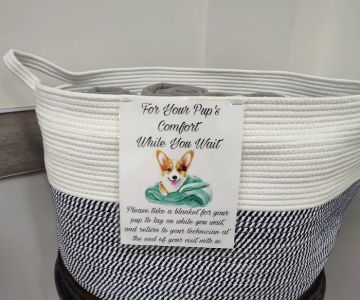How to Care for Your Pet’s Paws and Nails Properly
As a pet owner, one of the most important aspects of maintaining your pet’s health is ensuring that their paws and nails are well cared for. I’ll never forget the first time I realized how much I neglected my dog’s paw care. After a few outdoor runs on rough terrain, my dog started limping, and I was devastated. Upon inspection, I discovered that his nails were too long and his paw pads were irritated. That was a wake-up call for me, and ever since, I've been more mindful of his paw health, ensuring that his paws are well-maintained and his nails are properly trimmed.
Taking care of your pet’s paws and nails might seem simple, but it's an essential part of their overall well-being. Whether you have a dog, cat, or other furry companion, paws and nails play a significant role in their mobility and comfort. In this article, I’ll guide you through the process of caring for your pet’s paws and nails properly, so your pet stays happy, healthy, and comfortable.
1. Why Paw and Nail Care Is So Important
The health of your pet’s paws and nails is often overlooked, but it’s crucial for their comfort and mobility. Paws are exposed to all kinds of conditions, from rough surfaces to extreme temperatures, and their nails are put under constant stress as your pet walks, runs, and plays. Neglecting paw and nail care can lead to painful conditions such as cracked pads, infections, and difficulty walking. I’ve seen it happen firsthand when a pet’s nails are too long and start causing painful pressure on their feet, leading to discomfort and even difficulty moving.
Taking proper care of your pet’s paws and nails can prevent such issues. Regular grooming and paw health checks will help avoid injuries, infections, and conditions that can affect your pet’s overall quality of life. A well-maintained set of paws and nails also allows your pet to enjoy their favorite activities, whether it’s running on a trail, playing fetch, or simply going for a walk without discomfort.
2. How to Properly Trim Your Pet’s Nails
Trimming your pet’s nails is a key part of paw care, but it’s also one of the tasks that can make many pet owners nervous. I used to be scared of cutting my dog’s nails too short, but over time, I learned how to do it safely and effectively. The key is to have the right tools and a calm, patient approach.
2.1. Choosing the Right Nail Clippers
When I first started trimming my pet’s nails, I didn’t realize how important it was to use the right nail clippers. Using clippers that are designed for pets ensures that you have the proper tool to handle their nails safely. There are different types of nail clippers available, including scissor-style clippers and guillotine-style clippers. I personally prefer the scissor-style ones for my dog, as they give me more control and are easier to handle. For smaller pets or cats, guillotine-style clippers work well.
2.2. Finding the Right Spot
Before I trim my pet’s nails, I always make sure to have them in a comfortable position. I usually place my dog on a non-slippery surface like a mat or towel, making sure he feels relaxed. I’ve found that it’s easier to trim his nails when he’s calm and not overly excited. I gently lift his paw and press on his pads to extend the nails for easier trimming.
2.3. Cutting the Nails Safely
When it comes to cutting the nails, the goal is to avoid cutting into the quick, which is the sensitive, pink part of the nail that contains blood vessels. If you cut into the quick, it can cause bleeding and pain. I always make sure to trim the nails gradually, cutting small amounts at a time to avoid cutting too deep. If you’re unsure, it’s always better to trim less than more. It’s also helpful to trim your pet’s nails regularly to keep them from getting too long in the first place.
2.4. Dealing with the Quick
In case you do accidentally cut the quick, I keep styptic powder or cornstarch on hand to stop the bleeding. Applying pressure to the tip of the nail can also help, but it’s always good to have these tools available just in case. If your pet is particularly sensitive, or if you're unsure about trimming their nails yourself, consider visiting a groomer or veterinarian for professional nail care.
3. Caring for Your Pet’s Paws: A Step-by-Step Guide
In addition to trimming your pet’s nails, it’s essential to care for the entire paw, including the pads, between the toes, and the nails themselves. I’ve learned that regular paw care goes a long way in preventing discomfort or injuries caused by rough terrain, hot pavement, or dirt buildup.
3.1. Checking for Injuries or Irritation
After each walk or outdoor adventure, I always inspect my pet’s paws for any signs of injury or irritation. This includes checking for cuts, blisters, or foreign objects like rocks or thorns that may have gotten stuck between the toes. I also check for redness or swelling, which could indicate an infection or allergic reaction. If I notice anything unusual, I clean the area gently with warm water and pet-safe antiseptic, and I monitor the paw for a few days.
3.2. Moisturizing Dry Paw Pads
Dry, cracked paw pads are a common issue, especially in pets that spend a lot of time outdoors. I make sure to moisturize my dog’s paws with a pet-safe paw balm or cream. These balms help to keep the pads hydrated, soft, and protected from harsh conditions like cold weather, salt, or hot pavement. I apply the balm after each walk to keep his paws in the best condition possible.
3.3. Cleaning Your Pet’s Paws
After every outdoor adventure, I take a moment to clean my pet’s paws. This is especially important if we've been walking on dirt paths, beaches, or busy urban streets. I gently wipe his paws with a damp towel to remove dirt, mud, and any potential chemicals or allergens. This simple act not only keeps his paws clean but also helps prevent irritation or infections from buildup.
3.4. Paw Protection During Extreme Weather
During both the hot summer months and the colder winter months, it’s essential to protect my pet’s paws from extreme weather conditions. In summer, hot pavement can cause burns or irritation, so I always try to walk him early in the morning or late in the evening when the ground is cooler. In winter, I use dog boots or paw wax to protect his paws from ice, snow, and the chemicals used to melt the ice.
4. How Often Should You Care for Your Pet’s Paws and Nails?
The frequency of paw and nail care depends on your pet’s lifestyle and the environment they live in. I recommend trimming nails every 3-4 weeks for most dogs, but some pets may require more frequent care. For paw inspections and cleaning, I do this daily after walks, especially if we’ve been in rough conditions. Moisturizing the paw pads is something I do weekly to keep them soft and hydrated.
By staying consistent with paw and nail care, you can prevent potential issues and ensure your pet’s feet remain healthy and pain-free. Regular checks and maintenance will also help you spot any problems early, making it easier to treat them before they become more serious.
Whether you're a first-time pet owner or a seasoned pro, taking care of your pet's paws and nails should be a regular part of their grooming routine. A little attention goes a long way in ensuring they are happy, healthy, and comfortable every day.











